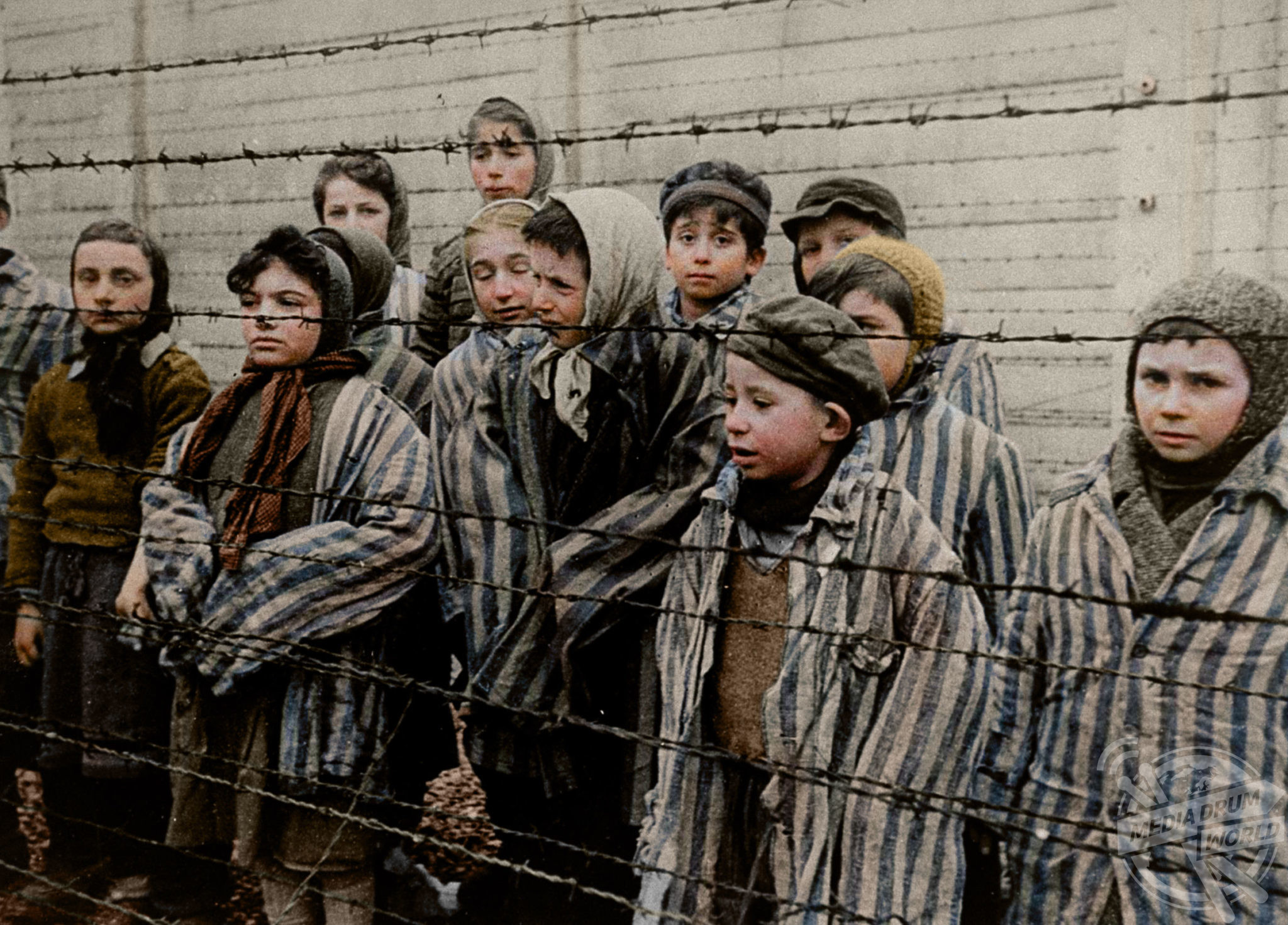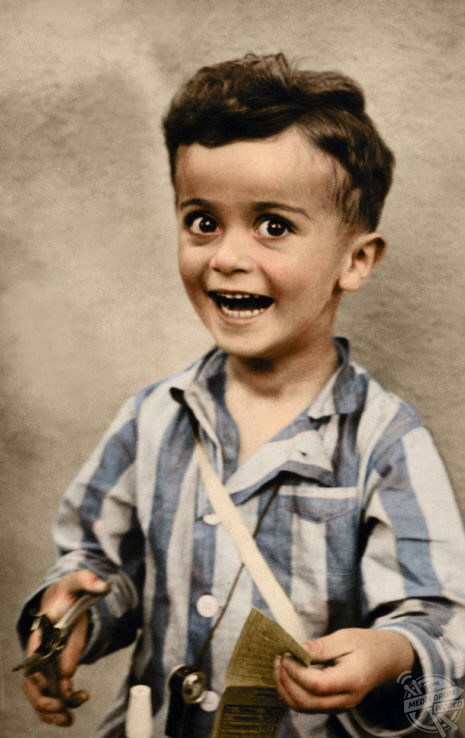
By Alex Jones
HARROWING colourised images of the Holocaust which expose the full terrors faced by the death camp’s inmates have emerged SEVENTY-FIVE-YEARS after the liberation of Auschwitz, the largest Nazi death camp.
Sobering photos, some revamped in colour for the first time, capture the horror of genocide in the eyes of a gaunt 18-year-old Russian woman; a concentration camp responsible for the deaths of tens of thousands of innocent people being ceremonially burnt to the ground by liberating British forces; and malnourished Jewish children peering out at their Soviet rescuers through a barbed wire fence at Auschwitz.
Other upsetting colourisations include a smiling portrait of four-year-old, Istvan Reiner, taken just a few weeks before he was murdered at the infamous death camp, and another showing a palpably relieved young Jewish refuge recuperating in hospital after being rescued by appalled Allied Forces.

For picture restorer and colouriser, Tom Marshall (31), of PhotograFix in Nottingham, UK, this project was the most emotionally draining in his career.
“I’ve been a photo colouriser professionally for six years and this is the most harrowing project I have ever worked on,” he said.
“I usually enjoy colourising photos as the process brings the subjects to life gradually which is a satisfying experience, but with this project it simply upset me as the images are so shocking.

“They serve as a stark reminder of man’s capacity for inhumanity. I had to give myself time to do something else and try to switch off whilst working on these photos as they made me angry, and I felt more sick as the pictures came to life, but I feel it was an important thing to do, to remind people – especially younger generations, that this happened and that it’s not really THAT far back in history. Many people my age will have a grandparent who was alive when these photos were taken.”
Human history has a few tragedies that rival the magnitude and moral bankruptcy of the Holocaust, the systematic state-sponsored killing of 6,000,000 Jewish men, women, and children and millions of others by The Third Reich and its allies during World War II.
Soviet soldiers liberated Auschwitz-Birkenau on January 27, 1945. They found several thousand emaciated survivors, and the smouldering remains of the gas chambers and crematoria – the Nazis’ attempt to destroy evidence of their crimes against humanity. January 27 is now the date of Holocaust Memorial Day – a day to remember not only the Nazi’s anti-Semitic crusade, but numerous other genocides which have taken place over the last 75 years.

From their ascension to power in 1933, Hitler and his Nazi party implemented a racially motivated hate campaign against German Jews. With the outbreak of World War Two in 1939 Germany invaded Poland, subjecting around two million Polish Jews to violence and forced labour. Thousands of Jews were murdered in the first months of the occupation. Shortly after the occupation, Polish Jews were confined to particular neighbourhoods that came to be known as ‘ghettos’. Living conditions in these ghettos were appalling – a deliberate attempt by the Nazis to cause the deaths of hundreds of thousands of Jews. This approach was repeated across Eastern Europe in other countries occupied by the Nazis.
In 1941, the systematic murder of Europe’s Jews began – a plan known by the Nazis as ‘The Final Solution to the Jewish Problem’. Death squads called Einsatzgruppen swept Eastern Europe and the Soviet Union, killing Jews by firing squad. By the end of 1941 the first extermination camp, Chelmno in Poland, had been established, giving the Nazis their method to continue murdering on a unfathomable scale between 1941 and 1945.
By the end of the Holocaust, 6,000,000 Jewish men, women and children had been slaughtered by gas chambers, rifle, malnutrition, suicide, or disease.

As the Second World War ravaged Europe, the desperate state of affairs for Jews – as well as Roma, gypsies, blacks, slavs, disabled, or gay people who the Nazis deemed unworthy of their master ‘Aryan’ race – was not well known. As Allied troops made progress across Nazi-occupied Europe, they began to uncover concentration and extermination camps. The camp of Majdanek in Poland was the first to be liberated, in the summer of 1944.
Nazi forces – aware the war had turned against them and they would have to answer for their inhumane acts – burnt the gas chambers and the mass graves in attempts to hide the crimes that had been committed. The camps of Sobibor, Belzec, and Treblinka were dismantled by the Nazis from 1943, and Auschwitz was evacuated in late 1944. The remaining prisoners from each camp were forced to walk from Poland to camps in Germany. Already suffering from starvation and ill-treatment, and poorly clothed against elements, many thousands died on these enforced death marches.
Hundreds of thousands of victims have still not been identified, three quarters of a century later.

For the 400,000 or so survivors of the Nazi war machine’s concentration camps, the nightmare still continues as the repercussions of the grotesque actions of the 1940s continue to haunt their dreams.
“Never shall I forget the little faces of the children, whose bodies turned into wreaths of smoke beneath a silent blue sky,” says Elie Wiesel, a holocaust survivor, echoing the thoughts of many of her peers.
These shocking colourised images present the stark realisation that the Nazi’s atrocious actions took place just years after mankind had invented the photocopier, the jet engine, or colour TV. Colour film was readily available in 1945 but was costly so not widely used.

Marshall believes his colourised photographs may help serve a greater purpose.
“It is so important, especially as the years go on, that we do more to bring the past to life, and keep images like these relevant and shocking, so this never happens again,” he added.
“The colourising process was also different as these people were close to death by the time of their liberation, so painting skin tones was completely different. In colour you can see the bones and the bloodless skin, and even young men look older with greying hair and dark patches around their eyes.

“I have also included two photos taken by my great-grandfather, CMK Parsons, who was a chaplain with the British Army and helped to liberate Bergen-Belsen in April 1945. Like many people affected by the horrors they saw during the war, CMK Parsons never really spoke about his experiences at Bergen-Belsen and these photos show why.”
A spokesperson for the Holocaust Memorial Day Trust was hopeful that by remembering the dreadful acts of our past, we can avoid repeating our actions in the future – but warns that humankind has already slipped numerous times.
“The Holocaust was a terrible and defining episode of the twentieth century, which undoubtedly changed the course of history,” the spokesperson said.

“After the Holocaust, the international community adopted a legal definition of the crime of ‘genocide’. They wanted to make sure that never again would the crimes of the Holocaust be allowed to happen.
“However, in the years following the Holocaust, genocide has continued to be carried out. On Holocaust Memorial Day we remember all those who were murdered or affected by the genocides in Cambodia, Rwanda, Bosnia and Darfur.
“Subsequent genocides represent a failure of humanity to learn from the Holocaust and are a reminder for all of us that we must be prepared to guard against genocide happening again in the future.”






